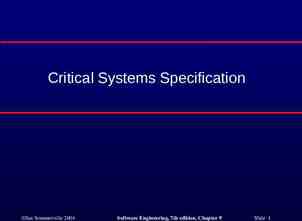Selling BizTalk-Based Engagements David Chappell Chappell
54 Slides2.93 MB

Selling BizTalk-Based Engagements David Chappell Chappell & Associates www.davidchappell.com

Agenda Key Questions and Answers Recognizing Integration Opportunities Complements, Alternatives, and Competitors to BizTalk Server Appendix: BizTalk Server Basics “These are quotes from sales principals in Microsoft partners that provide a substantial integration capability.”

1 Key Questions and Answers

What Do Integration Deals Look Like? Using BizTalk Server Multi-site consolidation with heterogeneous systems Professional services fee 18,000,000 Person months of effort 680 Gross profit 10,800,000 Gross margin Professional services fee 60% 1,000,000 Person months of effort Gross profit 45 400,000 Gross margin Professional services fee Person months of effort Gross profit Gross margin Professional services fee Person months of effort Gross profit Gross margin Multiple apps and integration points with fault tolerance, clustering, etc. Custom app development plus integration 40% 250,000 15 125,000 50% 30,000 Small scoping project plus initial build 1 13,500 45% Source: Microsoft BizTalk partners interviewed by IDC, 2006

What’s Being Sold? Clients want business value Integration is a means to this end “We talk to our customers about their business problems first, and we bring candidate technologies to the table to address those business problems.” Selling engagements that include integration typically means selling solutions “Don’t lead with BizTalk. Instead, lead with business process knowledge, integration knowledge, and architectural knowledge.”

How Does the Sales Process Look? “Once you’re past the initial conversation, the discussion will invariably turn technical. Nothing replaces having a BizTalk architect by your side.” Qualify Envision Proof ? Sales Principal Close Sales BizTalk Principal Architect BizTalk Developers Architect Sales Principal

How Long is the Sales Process? For customers with no installed integration products: Commonly 6 to 9 months “You need to be able to sustain a long sales process. There’s no quick money.” For current BizTalk Server customers: Perhaps 3 months

What’s Needed to Get Started? A solution-oriented mindset Knowledge of both business and technology issues Perhaps divided among different people on the sales team Prospects with integration problems Allowing you to expand current conversations The ability to recognize integration opportunities

2 Recognizing Integration Opportunities

Recognizing When Integration is Required Words to Listen For “We need to connect . . .” “We’ve just acquired another company” “We’re merging with . . .” “We need to access legacy systems”

Categorizing Customers Information Technology Decision Makers (ITDMs): Want solutions to IT problems; involved in solving business problems Business Decision Makers (BDMs): Want solutions to business problems IT Business Groups

Categorizing BizTalk-Based Projects Typical Business Problems Business Process Automation EAI Keeping information in B2BI sync across multiple applications Displaying diverse information from different applications Connecting suppliers with their customers Replacing manual processes Providing real-time information about running business processes Managing sets of business rules Tracking business processes for compliance

EAI: Keeping Information in Sync An Example BizTalk Server Siebel CRM Business Users Customer Data .NET Application Customer Data SAP ERP Customer Data Business Users

EAI: Keeping Information in Sync Business Goals Make business processes more effective and more consistent By allowing changes to information in one application to be automatically reflected in other applications Reduce costs Such as by connecting different parts of a business without requiring manual re-entry

EAI: Keeping Information in Sync Words to Listen For “Our systems don’t talk to each other” “Our users don’t have the information they need” “I need information in one system that’s kept in another”

EAI: Displaying Diverse Information An Example Employees Customers User Interface BizTalk Server Lending Application Retail Banking Application Mutual Funds Application Customer Data Customer Data Customer Data

EAI: Displaying Diverse Information Business Goals Increase customer satisfaction By allowing direct access to current information, e.g., shipping status or financial information Reduce costs Such as by hiring fewer call center employees Increase revenues Such as by improving cross-selling based on employee access to current and complete customer information

EAI: Displaying Diverse Information Words to Listen For “People have to go to many different applications to get their work done” “Employees have five different applications running on their desktop” “We need a common view of customers/patients/ ”

B2BI An Example Customer Supplier BizTalk Server EDI JD Edwards Business Users

B2BI Business Goals Lower costs and improve quality of interaction with suppliers Comply with customer mandates Big firms commonly force their suppliers to connect electronically Comply with government and industry mandates For health care, banking, and more

B2BI Words to Listen For “EDI” “AS2” “Supply chain management” Health Care: “HIPAA”, “HL7” “X12” “EDIFACT” High Tech: “RosettaNet” Financial Services: “SWIFT”

Business Process Automation Business Goals Reduce manual effort And improve cycle times Provide real-time process information Via business activity monitoring (BAM) Manage complex sets of business rules With a business rules engine (BRE) Track business processes for compliance And improve visibility into those processes

Business Process Automation An Example Business Users BAM BizTalk Server BRE Siebel CRM Business Users Tracking .NET Application SAP ERP Business Users

Business Process Automation Words to Listen For “Faster time to market” “Faster cycle times” “Business rules” “Visibility” “Audit trails” “Compliance” “Sarbanes-Oxley”, “SOX”, “SarbOx” Financial Services: “Basel II”

Categorizing BizTalk-Based Projects Typical IT Problems Simplicity Replacing complex custom integration Replacing integration done with older technologies Service-Oriented Architecture (SOA) Exposing web services from existing applications Providing an enterprise service bus (ESB)

Simplicity Improving What’s Already There Organizations often have: Complex custom integration solutions Or solutions based on older integration products Mission-critical data in legacy systems BizTalk Server-based projects can: Provide more control Save money Safely wrap legacy applications Without changing them

SOA Supporting the Move to Services SOA can provide a common way to access new and existing applications “Many companies are starting to move to SOA, which is also driving the need for BizTalk engagements.” BizTalk Server-based projects can: Expose the functions of one or more applications as web services Provide the services of an ESB Such as message-based communication, data transformation, and more

IT Problems Words to Listen For “Complex, fragile integration” “We’re scared to touch anything” “Service-oriented” “ESB” “SOA”

Microsoft Support FY07 BizTalk Server Campaigns Cross-industry campaigns: Business Intelligence: BAM and more SOA and Business Process Vertical industry campaigns: Manufacturing ” t c e n n o “C B2BI: Connecting with trading partners Supply chain visibility Retail B2BI: Connecting with trading partners Supply chain visibility RFID

Microsoft Support Infrastructure Optimization (IO) Models IO models categorize an organization into one of four levels: Basic, Standardized, Advanced, Dynamic The Application Platform IO Model (APIOM) includes SOA and Business Process The process of categorizing a customer can help discover opportunities For more information, see http://www.microsoftio.com

3 Complements, Alternatives, and Competitors to BizTalk Server

Summarizing the Landscape Complements Host Integration Server Microsoft Operations Manager BizTalk ISV Partners Alternatives Windows SharePoint Services SQL Server Integration Services Windows Workflow Foundation Competitors Doing nothing Custom code Other vendors IBM SAP Oracle BEA Tibco WebMethods Sun’s SeeBeyond

Complements Host Integration Server (HIS) Connects to IBM systems Microsoft Operations Manager (MOM) Supports a management pack for BizTalk Server BizTalk ISV partners Human workflow: SourceCode’s K2.net Captaris BPM: http://www.microsoft.com/biztalk/solutions/bpm/partners .mspx

Alternatives SQL Server Integration Services (SSIS) SSIS focuses on Extract, Transform, and Load (ETL) of data Windows SharePoint Services (WSS) 3.0 Supports human workflows Can be connected to BizTalk Server Windows Workflow Foundation (WF) Allows creating workflow-driven applications BizTalk Server provides many more services, however

Competitors Doing Nothing Is spending money on integration worthwhile for this prospect? It might not be Beating this competitor requires building a convincing business case for your solution

Competitors Custom Development (1) Writing all of the integration code yourself can be the right solution Such as for simple point-to-point problems For more complex scenarios, an integration product is better “If customers won’t invest in BizTalk when it’s warranted, the end result takes longer to build, is harder to scale and extend, and more expensive to maintain. It’s better for the overall solution, and thus better for the partner, to sell the right technology.”

Competitors Custom Development (2) BizTalk Server provides: Adapters and accelerators Data mapping “Whatever solution you build, you want to do the Graphical tools best thing for the customer.” Security Persistence Reliability/failover Scalability Management tools

Competitors The Vendor Landscape

Competitors General Truths All built their integration product suites at least partially by acquisition So they’re typically more complex to use and less mature than BizTalk Server All charge extra for individual features, such as BAM and a BRE BizTalk Server includes all of these things So BizTalk Server is typically less expensive None work as well with other Microsoft software as BizTalk Server

Competitors The Importance of Proof If a competitive proof of concept (POC) is done, BizTalk wins well over half of the time Primarily because of its ease of use But POCs aren’t just about technology What’s being proven is that your firm (and Microsoft) are good partners for this project Use the right people for the POC Domain expertise in whatever is being integrated, e.g., SAP, is commonly required

Competitors Important Factors in a Competitive Situation Help the Sale Hurt the Sale The partner: The partner: Can demonstrate rapid ROI Can’t demonstrate rapid ROI Has strong knowledge in this Lacks strong knowledge in this vertical market vertical market A POC demonstrates high productivity using BizTalk Server The customer is already using BizTalk Server The POC or the entire decision is driven by a non-Microsoft-friendly person .NET is a large part of the development environment .NET isn’t a large part of the development environment A competing product is already entrenched

Conclusion What to Do Next Understand the problems your customers face Recognize when integration should be part of the solution Help the customer recognize this, too Close the deal

Appendix: BizTalk Server Basics

The History of BizTalk Server 2000 2002 2004 2006 2007 BizTalk Server 2000 BizTalk Server 2002 BizTalk Server 2004 .NET-based rewrite BizTalk Server 2006 BizTalk Server 2006, R2

Illustrating BizTalk Server 2006 Visual Studio 2005 Orchestration Designer Business Activity Monitoring (BAM) Business Rules Engine (BRE) Accelerators HL7 SWIFT . Other s Health and Activity Tracking (HAT) Orchestration SAP Data Mapping IBM Mainframes Adapters Web Services File WebSphere MQ SAP . Others Java Applications Other Tracking Message Box

BizTalk Server 2006 Standard Edition Limited to two CPUs on one server Allows a maximum of five applications BizTalk Server BizTalk Server or SQL Server SQL Server

BizTalk Server 2006 Enterprise Edition Allows multiple servers for reliability and scalability Allows an unlimited number of applications BizTalk Server BizTalk Server SQL Server SQL Server

Adapters Making Connections Included with BizTalk Server: SAP, PeopleSoft, Siebel, JD Edwards, WebSphere MQ, many more Complete list: http://www.microsoft.com/biztalk/evaluation/ ad apter/default.mspx Available from partners: http://www.microsoft.com/biztalk/evaluation/ ad apter/partner/2004.mspx

Selling BizTalk Licenses Selling a solution that includes BizTalk Server requires convincing customers that the license fee will ultimately save them money This is easier with customers who understand the business value of integration “We sell ROI, making the BizTalk license just a line item to get this return.”

BizTalk Server 2006 Pricing Developer Edition: 499/user Limited to developing and testing solutions Standard Edition: 8,499/CPU Enterprise Edition: 29,999/CPU SQL Server is also required: Standard Edition: 5,999/CPU Enterprise Edition: 24,999/CPU

BizTalk Server 2006 Pricing Example Configurations Configuration Required Licenses BizTalk Server Standard Edition: 2 CPUs Basic: One instance of BizTalk Server with one message box on SQL Server Standard a single 2-CPU server Edition: 2 CPUs “You have to be up front about what it’s going to cost.” BizTalk SQL Total Server Server License Licenses Licenses Cost 16,998 11,998 28,996 Redundant: Two instances of BizTalk Server, each running on its own 2-CPU server, with one clustered message box, each running on its own 2-CPU server BizTalk Server Enterprise Edition: 4 CPUs SQL Server Standard Edition: 2 CPUs 119,996 11,998 131,994 High-throughput: Four instances of BizTalk Server, each running on its own 2-CPU server, with one clustered message box and one clustered tracking database, each running on its own 2-CPU server BizTalk Server Enterprise Edition: 8 CPUs SQL Server Enterprise Edition: 4 CPUs 239,992 99,996 339,988

Competitor Pricing A Reality Check According to Gartner, the average sale price for a major vendor’s integration suite in 2005 was 700,000 “If the customer is only willing to spend 100,000200,000 on an integration product, you can’t even really get started with anything except BizTalk .” BizTalk Server’s lower price leaves more money for services in the customer’s budget

For More Information BizTalk Server Home Page http://www.microsoft.com/biztalk/default.mspx Microsoft Case Studies for BizTalk Server 2006 http://www.microsoft.com/biztalk/evaluation/ casestudies/2 006.aspx?ddiDirectoryID 478 Partner Sales and Marketing Support https://partner.microsoft.com/global/salesmarketing/create demand/40028350

About the Speaker David Chappell is Principal of Chappell & Associates (www.davidchappell.com) in San Francisco, California. Through his speaking, writing, and consulting, he helps information technology professionals understand, use, and make better decisions about enterprise software. David has been the keynote speaker for many events and conferences in the U.S., Europe, Asia, and Latin America, and his seminars have been attended by tens of thousands of developers, architects, and decision makers in forty countries. David’s books on enterprise software have been published in ten languages and used in courses at MIT, ETH Zurich, and dozens of other universities. In his consulting practice, he has helped clients such as Hewlett-Packard, IBM, Microsoft, Stanford University, and Target Corporation adopt new technologies, market new products, train their sales staffs, and create business plans. David’s comments have appeared in the New York Times, CNN.com, and many other publications. Earlier in his career, David wrote software for supercomputers, chaired a U.S. national standards working group, and played keyboards with the Peabody-award-winning Children’s Radio Theater. He holds a B.S. in Economics and an M.S. in Computer Science, both from the University of Wisconsin-Madison.






